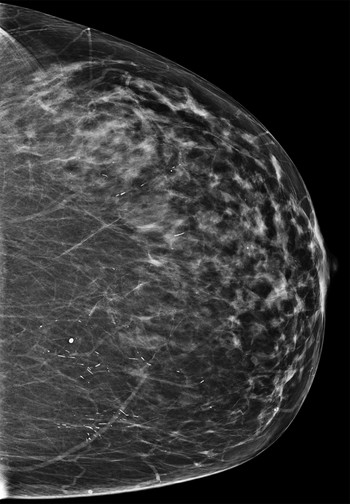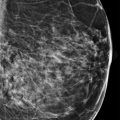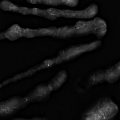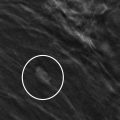Presentation and Presenting Images
A 65-year-old female with a history of right breast cancer treated 4 years ago presents for asymptomatic screening mammography.
61.2 Key Images
61.2.1 Breast Tissue Density
There are scattered areas of fibroglandular density.
61.2.2 Imaging Findings
In the upper outer quadrant of the left breast there is a small area of architectural distortion at the 1 o’clock location in the posterior depth ( ▶ Fig. 61.3 and ▶ Fig. 61.4). It is best seen on the tomosynthesis images; however, it can be seen retrospectively on the conventional digital mammogram.
61.3 BI-RADS Classification and Action
Category 0: Mammography: Incomplete. Need additional imaging evaluation and/or prior mammograms for comparison.
61.4 Diagnostic Imaging
( ▶ Fig. 61.5, ▶ Fig. 61.6, ▶ Fig. 61.7, ▶ Fig. 61.8, ▶ Fig. 61.9, ▶ Fig. 61.10, ▶ Fig. 61.11, ▶ Fig. 61.12)
61.4.1 Imaging Findings
Sometimes small areas of architectural distortion can resolve with additional imaging. In this diagnostic evaluation, spot-compression digital breast tomosynthesis (DBT) combination views were obtained in the craniocaudal (CC) ( ▶ Fig. 61.5 and ▶ Fig. 61.7) and mediolateral (ML) projections ( ▶ Fig. 61.9 and ▶ Fig. 61.11). The imaging confirms a 6-mm irregular mass with indistinct and spiculated margins at the 1 o’clock location 14 cm from the nipple. A targeted ultrasound reveals a 3 × 6 × 4 mm hypoechoic mass with posterior acoustic shadowing ( ▶ Fig. 61.12). The axillary lymph nodes were normal (not shown).
61.5 BI-RADS Classification and Action
Category 4B: Moderate suspicion for malignancy
61.6 Differential Diagnosis
Invasive cancer: Although this lesion is small, it has suspicious features and the biopsy revealed invasive tubulolobular carcinoma.
Fibromatosis: Fibromatosis is not very common (0.2% of all breast tumors). These lesions present as small spiculated lesions near the chest wall and often mimic breast cancer on imaging.
Radial scar: Radial scars can mimic breast cancers and would be consistent with the presentation of this lesion.
61.7 Essential Facts
Tubulolobular carcinoma is a subtype of mammary carcinoma with an incidence of 0.9%.
Currently tubulolobular carcinoma is thought to be a variant of a well-differentiated ductal carcinoma with a lobular growth pattern.
There is an excellent prognosis for patients with tubulolobular carcinoma with an over 90% 10-year survival rate.
Most tubulolobular carcinoma lesions are less than 2 cm in size, and they are often found on screening mammography.
Most common mammographic presentation of tubulolobular carcinoma is a mass without calcifications, of irregular shape, and with spiculated or indistinct margins.
The typical sonographic appearance of a tubulolobular carcinoma lesion is a hypoechoic, mass with spiculated or microlobulated margins, and with posterior acoustic shadowing in about half the cases.
61.8 Management and Digital Breast Tomosynthesis Principles
This lesion is very small and is in the midst of the anatomical noise of the underlying breast tissue. Spot-compression digital breast tomosynthesis (DBT) could help localize this finding and further help to characterize this small lesion. It would reveal the spiculated nature of the lesion, which is not fully appreciated on conventional diagnostic imaging.
Early studies suggest that DBT with full-field digital mammography (FFDM) appears to be better than FFDM and additional diagnostic imaging in over half of the assessments. DBT had better margin assessment than diagnostic imaging for noncalcified lesions.
DBT may be able to replace conventional diagnostic mammography for noncalcified lesions recalled from screening. Some studies suggest that these noncalcified lesions on screening DBT could bypass diagnostic mammography and proceed to ultrasound examination. Larger studies are needed to determine the optimal imaging protocol for attaining diagnostic information while minimizing patient radiation dose.
61.9 Further Reading
[1] Brandt KR, Craig DA, Hoskins TL, et al. Can digital breast tomosynthesis replace conventional diagnostic mammography views for screening recalls without calcifications? A comparison study in a simulated clinical setting. AJR Am J Roentgenol. 2013; 200(2): 291‐298 PubMed
[2] Günhan-Bilgen I, Oktay A. Tubulolobular carcinoma of the breast: clinical, mammographic and sonographic findings. Eur J Radiol. 2006; 60(3): 418‐424 PubMed
[3] Hakim CM, Catullo VJ, Chough DM, et al. Effect of the Availability of Prior Full-Field Digital Mammography and Digital Breast Tomosynthesis Images on the Interpretation of Mammograms. Radiology. 2015; 276(1): 65‐72 PubMed

Fig. 61.1 Left craniocaudal (LCC) mammogram.
Stay updated, free articles. Join our Telegram channel

Full access? Get Clinical Tree








